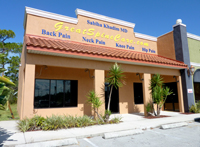The anatomy of the spine has 33 bones known as vertebrae divided into five regions: the cervical, the thoracic, the lumbar spine, the sacrum and coccyx bones.
The cervical, or neck section of the spine, consists of seven vertebrae known as C1 to C7. The top cervical vertebra is connected to the base of the skull.
The thoracic section of the spine is located at chest level, between the cervical and lumbar vertebrae. The 12 thoracic vertebrae, known as T1 to T12, also serves as attachments for the rib cage.
The lumbar section of the spine is located between the thoracic vertebrae and the sacrum. The five lumbar vertebrae, known as levels L1 to L5, are the main weight bearing section of the spinal column.
The sacrum section of the spine is located near the base of the spine. The sacrum consists of five fused vertebrae known as levels S1 to S5. It does not have discs separating the bones. The pelvis is connected to the spinal column of the sacrum section.
The coccyx, also called the tailbone, is at the base of the spinal column. It has 4 small vertebrae that are fused together.
Nerve roots are used to transmit information between the spinal cord and other parts of the body, such as arms, legs and organs.
Pedicles connect the lamina to the vertebra body.
Two transverse processes stick out of the sides of each vertebra. Muscles and ligaments that move and stabilize the vertebrae attach to the transverse processes.
The cylinder-shaped vertebral body is the weight-bearing structure of the vertebra.
The spinal cord has nerve pathways that carry signals, such as pain, from the arms, legs, and the body to the brain.
The spinous process protrudes from the back of each vertebra. Muscles and ligaments that move and stabilize the vertebrae attach to the spinous processes.
The articular facets are where two negihboring vertebrae attach.
Discs separate vertebrae. They are made of tough, elastic material that allows the spine to bend and twist naturally.
The flat plates of the lamina create the outer wall of the vertebral canal and help protect the spinal cord.
The spinal cord sits in this channel formed by the lamina and vertebra body.
